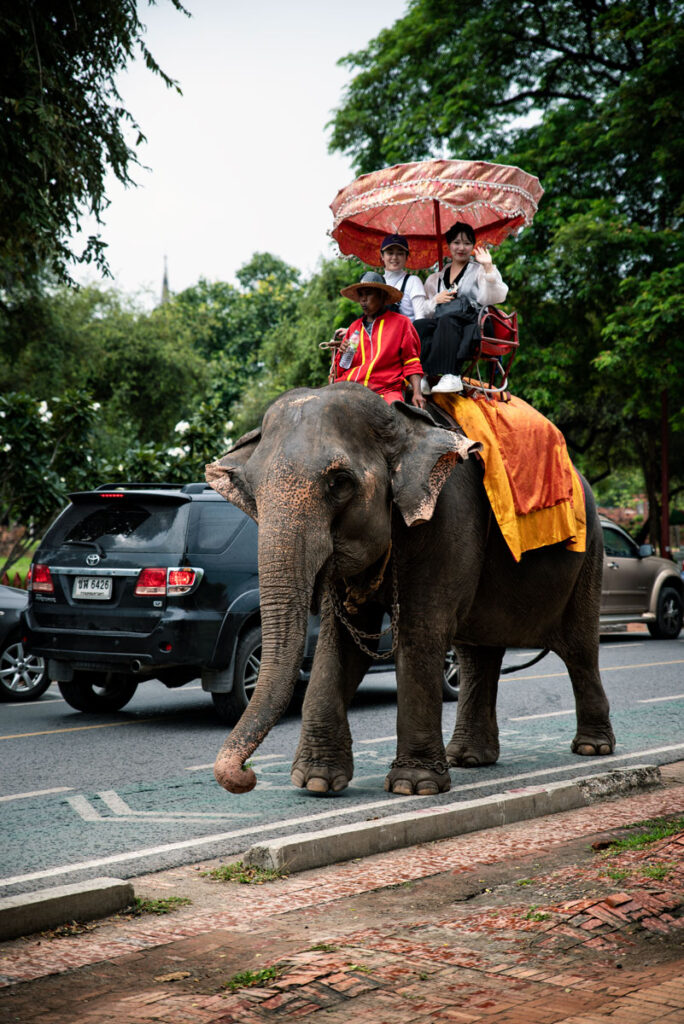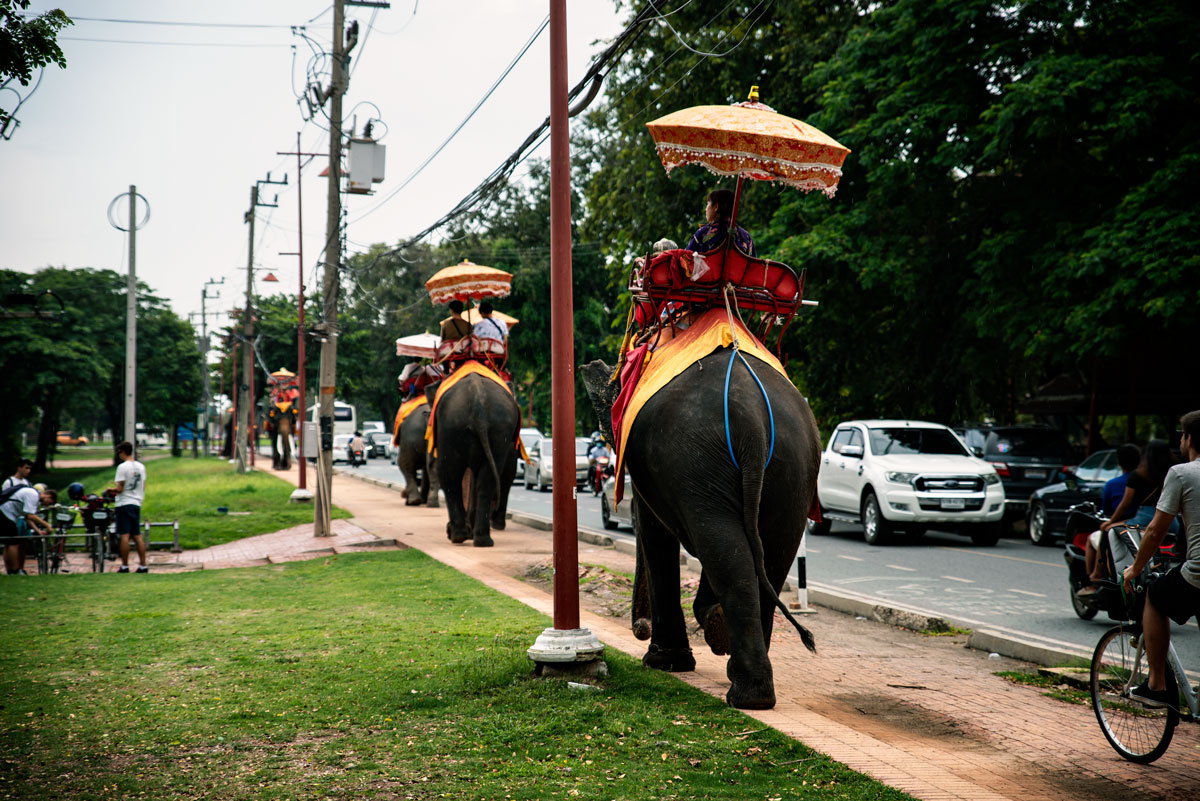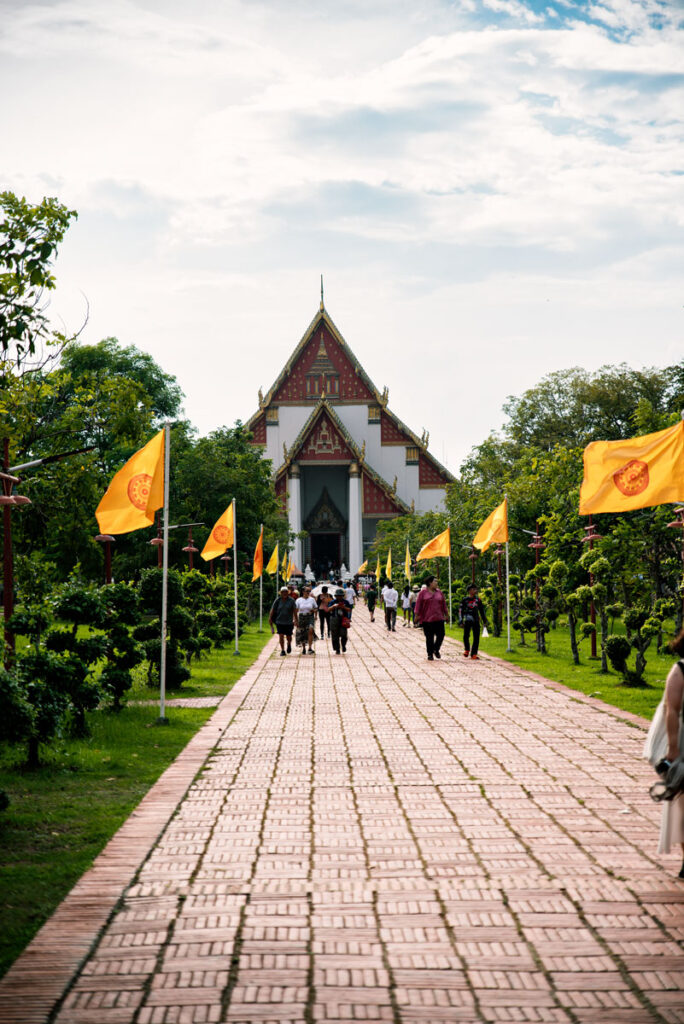Ayutthaya
Ayutthaya’s historical park only gives an idea of the fascination and amazement that the sight of the gigantic temples must have caused among the first European merchants who landed here in the 16th century. White pagodas stretching towards the sky. House-sized golden Buddha statues. The scent of jasmine flowers and joss sticks in the air. When the sun sank behind the city gates, thousands of lights illuminated this magical cosmopolitan city.
What remains is a historic park with numerous more or less well-preserved pagodas and temples. In 1767, soldiers from the neighboring kingdom of Burma destroyed the city after Ayutthaya had served as a magnificent capital and trading city for more than 400 years, since 1351.



The head of a Buddha statue entwined with roots bears witness to this attack by the Burmese. For many Thais, the sight of the headless statues is a painful reminder of a long-gone history. But even though this place is now just a ruin and barely approaches the sacred magnitude of the former city, the Thais treat it with respect. The boundaries between secular royalty, spiritual Buddhism and a heroic history are dissolving.
At some point, even the stones will crumble. What will remain is a fertile earth that brings new things. After Sukhothai perished, Ayutthaya was built. After this city was conquered, today’s capital Bangkok was founded a little further south. History repeats itself. Empires come and go. After thousands of years, all that will remain of even the greatest ruler is a line of text in a dusty book. Perhaps not even that.


Traffic flows between the temples. Elephants carry tourists on their backs. A plastic bag is blown across a meadow. The late afternoon casts long shadows and bathes the temples in a warm, golden light. Between the temple ruins, we almost forget what time we are in. Some of the complexes consist of nothing more than a large, crumbling stone platform, while other temples are well preserved and heavily frequented by travelers. Here and there you will find a small chedi or a temple corridor where you can enjoy the silence undisturbed.
Vanys Tip
Don’t be tempted to be carried around on the back of an elephant. As a rule, such elephants are kept in questionable conditions and are anything but species-appropriate. In fact, there are only a few good and animal-friendly facilities where you can see elephants up close and interact with them. If you are as passionate about elephants as I am, then you should visit the Save Elephant Foundation near Chiang Mai. We have been supporting this foundation for several years now. Everything is very transparent and you have the opportunity to sponsor and visit elephants.




Before the historical park closes in the late afternoon, we make a detour to the restored temple Wihan Phra Mongkhon Bophit. The almost thirteen-meter-tall Buddha statue inside has been destroyed and rebuilt several times over the last few centuries. The temple is well visited and gives an impression of how rich in treasures and frequented Ayutthaya must once have been.


On the way back to the car – it is already dusk and we have bought a “roti” at the roadside as an early dinner – we hear rock music coming from the historic park. We follow the music and arrive at a festival consisting of food stalls, a petting zoo and a centrally erected stage. The outlines of the temple ruins can be seen in the background.
Ayutthaya is not a dead archaeologist’s dream, but a lively city.
Info about our trip
For all those with at least a little interest in Thailand’s history, a visit to the historical park in Ayutthaya is a must. The city can be reached in under two hours from Bangkok. The best way to get there is by train from Bangkok’s former main station Hua Lamphong (there are cheap slow trains and slightly more expensive express trains) or you can book a bus. Both are about the same price and equally fast.
You can travel to Ayutthaya in the morning and back to Bangkok the same evening. It is of course more relaxed to stay one night in Ayutthaya, but bear in mind that the range of hotels / guesthouses and dining options is limited – the city is oriented towards day tourists.
If you are heading north to Chiang Mai, Chiang Rai and / or Phai, then a stop in Ayutthaya can be perfectly combined with your route.
On the one hand, Ayutthaya is a tourist city, but on the other hand, the sidewalks are rolled up after 6 pm and there is not much going on. This keeps prices at an average level for Thailand. Note that most of the temples worth seeing charge an entrance fee. You pay around 1.50 euros (50 baht) per temple. So expect to pay around 200-300 baht per person if you want to visit the most beautiful sites.
We had difficulty finding a good, substantial breakfast on a Sunday morning. Most of the breakfast places (there are actually not that many) were closed on Sundays or only opened after 10am. You should have fewer problems during the week, but if you are lucky enough to be in Ayutthaya on a Sunday, as we were, we recommend Sonny Coffee & Juice.
In the evening, we ended up at the Garden Side Restaurant Meet Up. The staff were a little suspicious of us, it seemed, and the decor is simple and very Thai. You could also describe it as authentic 😉 But the food was fine. There are also a few dishes on the menu that you won’t find in every tourist restaurant.
We spent one night in Ayutthaya and stayed at the Warehouse. It’s not a hotel, but a small homestay. Very clean and as good as new, but on the outskirts of the city. We were there with our own car and were happy about the parking lot in front of the door. So it was no problem to go out for dinner by car. Ayutthaya doesn’t have any nightlife to offer anyway and you will definitely find a 7/11 and a small number of restaurants within walking distance of the Warehouse.
Ayutthaya is a relaxed city and, like almost everywhere in Asia, very safe. In the historic park itself, you don’t even have to worry about driving on the left – you can take a relaxed stroll or ride your bike here.
Thai society is very open-hearted and fond of children. It was not uncommon to see a bunch of Thais (mainly women) standing around our boy. The way Thais treat children is different to what we are used to in Europe. We would never go up to a stranger’s child and want to take it in our arms. This happens all the time in Thailand – people don’t even ask beforehand. You should also be prepared for Thais to take photos of your children – often without being asked. They will quickly whip out their smartphone and take a selfie with the blond, little farang (foreigner). Think about how you want to deal with this – from our Western perspective – cross-border behavior. You won’t always be able to prevent it. Be respectful and smile and let your counterpart know that you would like a little more distance. At the same time, you are even more welcome everywhere with children and we were often given preferential treatment (e.g. in queues).
However, don’t expect extra changing rooms anywhere – the sanitary facilities are often in an inadequate condition anyway. So take wet wipes and disinfectant gel with you. You can buy basic baby supplies in any 7/11 or supermarket. Diapers are not cheap and are often only available in large packs. It’s best to leave the baby carriage/stroller at home. The sidewalks are usually too bad and there are too many pedestrians and cars, especially in Bangkok, so you won’t have much fun with it. The most flexible option is a baby carrier.
The best way to get to Ayutthaya is by bus or train from Bangkok. Once in the city, you can hire a bike for very little money and explore the surrounding area. You can also explore the historical park by foot, but then plan two days for Ayutthaya.
In general, we have been touring Thailand for years in rental cars, which can be hired anywhere and are quite cheap. However, we advise against renting a car as a self-driver without experience of Asian traffic and left-hand traffic in general. But renting a car is not necessary in Thailand. The transport network in and between the cities is perfect. You have all the options: Private cab, minibus, intercity bus, scooter, (night) train, plane and ferry. All options are affordable, but of course vary in comfort and speed. You can’t go wrong with any of these means of transportation. Just don’t get ripped off – there are always a few cab drivers or ticket sellers at the tourist spots who will offer you a ride for many times the price. Always buy your tickets at official ticket offices and don’t be fooled if they say the official sales point is closed today.
- Information on ruins in the historical park can be found on the visually outdated page www.ayutthaya-history.com
- You can also find basic information about Ayutthaya on the official tourism website of Thailand www.tourismthailand.org
- If you want to delve deeper into Ayutthaya’s history, read A History of Ayutthaya: Siam in the Early Modern World by Chris Baker
- A very good introduction to Thailand’s history in general can be found in Thailand’s Political History: From the 13th Century to Recent Times by B. J. Terwiel
